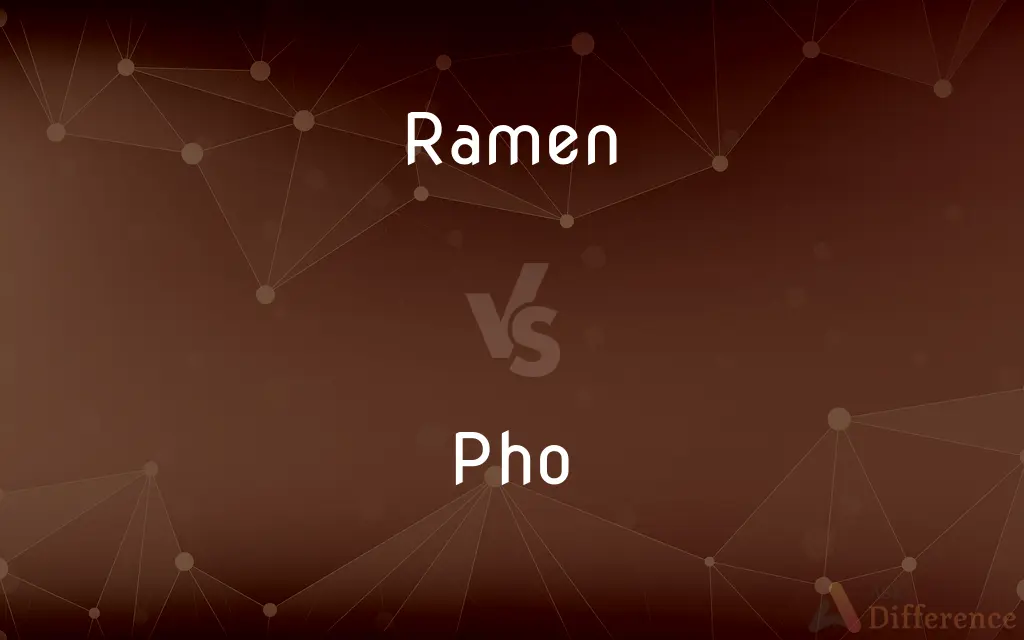Ramen vs. Pho — What's the Difference?
By Fiza Rafique & Urooj Arif — Updated on April 26, 2024
Ramen is a Japanese noodle soup known for its rich, meaty broth and wheat noodles, while Pho is a Vietnamese soup famous for its clear, aromatic broth and rice noodles.

Difference Between Ramen and Pho
Table of Contents
ADVERTISEMENT
Key Differences
Ramen, originating from Japan, typically features a broth that is rich and often cloudy, derived from meats like pork or chicken and flavored with soy sauce or miso. On the other hand, Pho, a staple of Vietnamese cuisine, boasts a clear broth that is light yet flavorful, made aromatic with spices like star anise and cinnamon and primarily based on beef or chicken.
Ramen is served with wheat noodles that are usually curly or thick, providing a chewy texture that complements its hearty broth. Whereas Pho includes flat, thin rice noodles which are smooth and slightly slippery, offering a delicate texture that absorbs the broth’s subtle flavors.
Toppings for ramen can include a wide array of ingredients such as sliced pork, boiled eggs, green onions, and bamboo shoots, contributing to its robust and varied flavor profile. In contrast, Pho is typically garnished with fresh herbs like basil and cilantro, lime wedges, and bean sprouts, enhancing the soup with fresh and crisp notes.
The preparation of ramen broth involves lengthy cooking times, often simmered for hours to extract deep flavors from bone and other ingredients. On the other hand, the preparation of pho broth, while also time-consuming, focuses more on achieving a clear and clean taste, with the spices and meat simmered carefully to maintain transparency.
Both ramen and pho are deeply embedded in their respective cultures as comfort foods and have gained international popularity, each offering a distinct yet satisfying experience. Ramen offers a hearty, comforting bowl with a focus on rich flavors and diverse textures, while pho provides a refreshing and aromatic meal, emphasizing clarity and simplicity.
ADVERTISEMENT
Comparison Chart
Origin
Japan
Vietnam
Broth Character
Rich, often cloudy
Clear, light, aromatic
Type of Noodles
Wheat, curly or thick
Rice, flat and thin
Common Toppings
Sliced pork, boiled eggs, green onions
Fresh herbs, lime wedges, bean sprouts
Flavor Profile
Meaty, often salty or savory
Light, aromatic with spices
Serving Temperature
Typically served hot
Typically served hot
Compare with Definitions
Ramen
Japanese noodle soup with a rich broth.
He ordered a bowl of ramen to warm up in the chilly weather.
Pho
Features rice noodles and is typically beef or chicken-based.
She ordered chicken pho with extra lime on the side.
Ramen
Served with wheat noodles and various toppings.
The ramen came topped with perfectly cooked eggs and bamboo shoots.
Pho
Vietnamese noodle soup known for its clear broth.
Pho is perfect for a light lunch on a hot day.
Ramen
Often flavored with soy sauce or miso.
She prefers miso ramen for its deep umami taste.
Pho
Garnished with fresh herbs and sprouts.
He loaded his pho with basil and bean sprouts for added freshness.
Ramen
A popular comfort food in Japan.
After a long day, a bowl of ramen is his go-to comfort food.
Pho
Considered a staple in Vietnamese cuisine.
Pho is as essential to Vietnamese culinary traditions as the baguette is to the French.
Ramen
Known for its hearty and diverse ingredients.
Ramen's appeal lies in its complex layering of flavors and textures.
Pho
Broth flavored with spices like star anise and cinnamon.
The aroma of star anise made the pho irresistibly fragrant.
Ramen
Ramen () (拉麺, ラーメン, rāmen, Japanese pronunciation: [ɾaꜜːmeɴ]) (literally: "pulled noodles") is a Japanese noodle soup. It consists of Chinese-style wheat noodles served in a meat or (occasionally) fish-based broth, often flavored with soy sauce or miso, and uses toppings such as sliced pork (叉焼, chāshū), nori (dried seaweed), menma, and scallions.
Pho
Phở or pho (UK: , US: , Canada: ; Vietnamese: [fəː˧˩˧] (listen)) is a Vietnamese soup dish consisting of broth, rice noodles (bánh phở), herbs, and meat (usually beef) (phở bò), sometimes chicken (phở gà). Pho is a popular food in Vietnam where it is served in households, street stalls and restaurants countrywide.
Ramen
(in Japanese cuisine) quick-cooking noodles, typically served in a broth with meat and vegetables.
Pho
A type of Vietnamese soup, typically made from beef stock and spices to which noodles and thinly sliced beef or chicken are added.
Ramen
A Japanese dish of noodles in broth, often garnished with small pieces of meat and vegetables.
Pho
A soup of Vietnamese origin typically consisting of rice noodles, onions, herbs, seasonings, and thinly sliced beef or chicken in a clear broth.
Ramen
A thin white noodle served in this dish.
Pho
A Vietnamese soup with a beef base, typically served with rice noodles and beef or chicken.
Ramen
Soup noodles of wheat, with various ingredients (Japanese style)
Pho
(archaic) Expressing dismissive contempt.
Ramen
A type of instant noodles.
Ramen
Amen
Common Curiosities
What makes ramen broth different from pho broth?
Ramen broth is typically richer and cloudier, often flavored with soy sauce or miso, whereas pho broth is clear, light, and spiced with elements like star anise and cinnamon.
What are the essential spices for pho broth?
Essential spices include star anise, cloves, cinnamon, cardamom, and coriander seeds.
Are ramen and pho healthy?
Both can be nutritious depending on the ingredients used; pho tends to be lighter, while ramen is more caloric due to its rich broth and toppings.
Can you substitute the noodles in ramen or pho?
Substituting noodles can alter the traditional experience, as the noodles in each dish are chosen to complement their respective broths and toppings.
How do toppings affect the flavor profiles of ramen and pho?
Toppings in ramen contribute to its richness and variety, whereas in pho, they enhance freshness and add crisp textures.
How long does it take to prepare authentic ramen or pho?
Both dishes involve lengthy preparation for the broth, often requiring hours of simmering to develop depth of flavor.
What is a good vegetarian option for ramen or pho?
Both dishes can be adapted for vegetarians using vegetable broths and toppings like tofu and a variety of vegetables.
What are some common mistakes when making ramen or pho at home?
Common mistakes include rushing the broth, which can lead to lack of depth in flavor.
Is ramen considered fast food in Japan?
While ramen can be served quickly, its preparation is anything but fast, requiring extensive cooking time.
Which dish is more popular internationally?
Both dishes are immensely popular worldwide, though ramen might edge out slightly in terms of global presence.
What is the best time of day to eat ramen or pho?
Both are suitable for any meal, but pho is often enjoyed as a breakfast in Vietnam, while ramen is popular as a lunch or dinner option.
What are future trends likely to influence ramen and pho?
Trends may include more health-conscious versions using alternative ingredients like gluten-free noodles or vegan broths.
Can ramen or pho be made quickly at home?
Quick versions are possible, but authentic flavors are best achieved with longer cooking times.
How has the popularity of ramen and pho influenced global cuisine?
Both have influenced global cuisine by introducing unique flavors and dishes that inspire fusion recipes.
How do you properly eat ramen or pho?
Ramen is typically eaten with chopsticks and a spoon, while pho is enjoyed with chopsticks for the noodles and a spoon for the broth.
Share Your Discovery

Previous Comparison
Population vs. Community
Next Comparison
Undefinable vs. IndefinableAuthor Spotlight
Written by
Fiza RafiqueFiza Rafique is a skilled content writer at AskDifference.com, where she meticulously refines and enhances written pieces. Drawing from her vast editorial expertise, Fiza ensures clarity, accuracy, and precision in every article. Passionate about language, she continually seeks to elevate the quality of content for readers worldwide.
Co-written by
Urooj ArifUrooj is a skilled content writer at Ask Difference, known for her exceptional ability to simplify complex topics into engaging and informative content. With a passion for research and a flair for clear, concise writing, she consistently delivers articles that resonate with our diverse audience.
















































